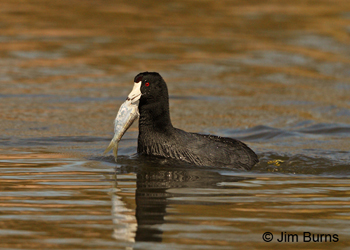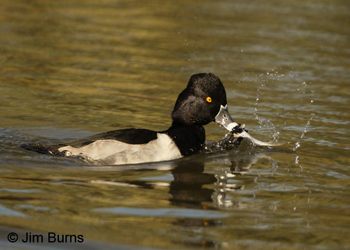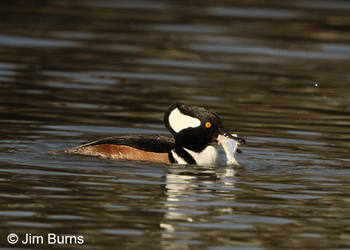|
|
|
Exact same fish, 3 different fishermen |
Three weeks ago on the Valley’s first really cold morning, I went over to Papago Park, my “local patch,” to see what I could see. Pretty much nothing, it turned out, for an hour or so, but I kept moving and around 10:45 perseverance was rewarded at the east pond where I witnessed the most fascinating and educational scenario of my birding year, a drama featuring a fish and three different species of water birds. But first, a rhetorical quiz for everyone.
If you were drawing up a template of a water bird built most efficiently for catching fish, which of these would it be?
A) A buoyant, blocky bird that rides high in the water and has a short, unserrated, conical bill without a tooth or a nail at the tip.
B) A bird of similar build, but a somewhat longer body and neck, that rides lower in the water and has a long, serrated, spatulate bill with a wide nail at the tip.
C) A more slender bird with an even longer body that rides very low in the water, and has a long, narrow, rapier bill, more deeply serrated with a dagger like tooth at the tip.
Sure, you’d build “C,” and then for good measure enhance its underwater vision with the ability to change lens shape and a more transparent nictitating membrane than its competitors. Nearly 50% of its diet would be fish, and you’d call it Hooded Merganser. Template “A,” which you labelled American Coot, would go into the folder with dabbling ducks which eat mostly grass and aquatic plants. Template “B,” Ring-necked Duck, you’d slip in with the diving ducks, but in the sub-folder with those that feed on seeds, tubers, and submerged vegetation, snails and clams in the winter and, alright, the occasional fish if they get lucky, because we know all birds are opportunistic feeders.
So, as I was watching the Neotropic Cormorants over at Papago catching what I’d call fingerlings, I became aware of a coot splashing around and ducking its head under water. It had found an injured fish left behind by the cormorant flotilla but was having trouble grasping it in its bill. The activity quickly attracted other coots, several Ring-necked Ducks, and two grackles making airborne sorties. The determined coot flipped, dragged, and herded the luckless fish across the width of the pond in front of me twice, followed by the mob of thieves, only to finally relinquished the prize to a Ring-necked Duck which kept attacking from the side and lunging at the coot’s head.
The duck, however, had little time to enjoy the spoils of victory because now the mob was following him, joined by a male Hooded Merganser that had materialized out of nowhere and utilized a completely different combat strategy. Built for underwater speed, the mergy repeatedly swam up under the duck, attacking from beneath and soon dislodged the now battered prey from the duck’s grasp.You wouldn’t go ice skating with roller blades and you wouldn’t go out to photograph birds with your cell phone. Equipment evolved for the task and enhanced by practiced technique are the order of the day for survival in the natural world.


